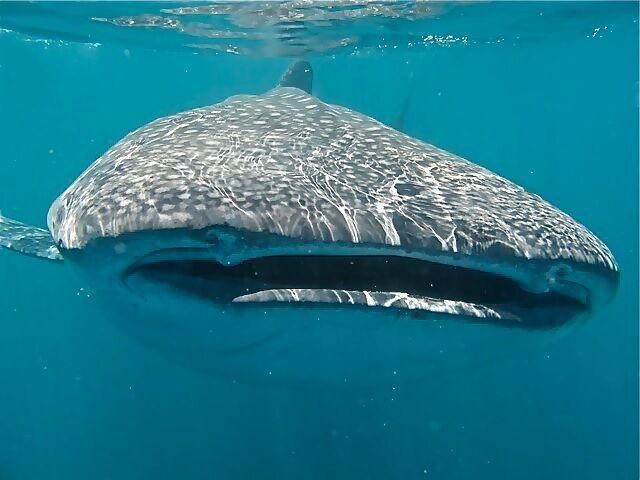What the Longest Known Whale Shark Migration Ever Tells Us About Conservation
Researchers in Panama tracked a specimen via satellite over an unprecedented 12,516 miles
/https://tf-cmsv2-smithsonianmag-media.s3.amazonaws.com/filer/0f/f4/0ff4a6fa-1c31-4e25-b266-6185577dc77d/shark1.jpeg)
Ever since Steven Spielberg terrorized summer moviegoers with Jaws in 1975, the word “shark” has been inextricably linked in the public imagination with scenes of toothy menaces out for blood. In actuality, even great whites are far more likely to leave humans alone than initiate any sort of violence, and they represent the fiercest portion of a long and lovely shark spectrum.
One species that tends not to garner as much press is the majestic whale shark (Rhincodon typus), whose rows of tiny teeth are not used for chomping at all. Rather, the broad, bespeckled animal is a filter feeder, harvesting plankton and small fish from the water simply by swimming about with its mouth agape—much like baleen whales. The benign leviathans can be found in equatorial waters all over the globe, but a recent paper published in the journal Marine Biodiversity Records focuses on a single organism, first sighted off the west coast of Panama.
It was there, in the waters of Coiba Island, that Smithsonian Tropical Research Institute marine biologist Héctor Guzmán (lead author) and his team affixed sophisticated tracking devices to the female shark at the center of the new study as well as two others in close proximity. The transmitters would enable the researchers to trace the movements of the animals across hundreds of days, and give them insight into the still poorly understood migratory behavior of this unique endangered species.
Guzmán says the transmitter bob attached to the shark had a torpedo shape to it, and that “the floating torpedo was anchored to the animal with a tether.” Each time the whale shark came up to the photic zone to trawl for plankton, the bob would rise to the surface and (with luck) be detected by one of a network of orbiting satellites. Called the Argos system after the many-eyed giant of Greek myth, the satellite array would periodically update Guzmán and his coworkers on the last known whereabouts of the whale shark (along with her two friends and a myriad of other tagged creatures moving about the world’s oceans).
Tag-and-track studies of this nature have been thwarted in the past by predatory fishermen and disrespectful tourists, who scare the whale sharks into the depths and force them to feed with quick vertical ascensions and descensions rather than the leisurely horizontal surface trawls they execute when unmolested. There’s also a risk of would-be Good Samaritans removing the harmless tracking device and ruining the scientific return.
Miraculously, in this instance, Guzmán and his collaborators were able to track their shark for nearly 850 days. Though naturally sporadic owing to extended periods of untraceable deep-water swimming, the data points laid out in the new paper combine to show a definite and remarkable trend: this whale shark, which began in the eastern Pacific off the west coast of Panama, journeyed some 12,516 miles to the western Pacific off the east coast of Guam, winding up at the famed Mariana Trench. No other whale shark has ever been observed to migrate that far.

Guzmán admits that he nearly gave up on this shark in late December 2012, when it had been missing in action for a staggering 235 days. It had remained in the vicinity of Panama for 116 days—an extremely well-documented period—then up and vanished. The last thing Guzmán had been expecting was for the creature to resurface 230 miles south of Hawaii. “I was about to disconnect the tag,” he says. “I was at my family home for Christmas when I saw this. That was a funny Christmas present!”
What could have driven a whale shark to cover such a tremendous distance? Guzmán has a few theories. One involves an ongoing search for fresh sources of food. “There might be more fish and little shrimp in eddies,” he says, so “following eddies makes sense for them.” The geology of the sea floor in the western Pacific is also conducive to the production of whale food. “From Hawaii to the Mariana Trench,” Guzmán says, “there are hundreds of sea mountains. Those are known for high productivity.”
Another theory links whale shark migration patterns to water temperatures—and in particular, thermal fronts. “We don’t have the evidence yet, but it’s starting to build,” Guzmán says. “Some whale shark trends seem to be associated with those fronts. By tracking them, we want to understand exactly that.” Guzmán is looking forward to the publication of a more ambitious follow-up paper, which will synthesize data collected from more than 30 separate whale shark specimens.
One of Guzmán’s primary hopes for the research that just went public is simply that it will remind people of the wonder and beauty of whale sharks, and the extent to which they are worldwide animals we should all be interested in safeguarding. From the predatory practices of heedless fishermen to the irresponsible waste disposal regimes that flood whale sharks’ bellies with garbage, there are many forces at play conspiring against the well-being of the species. Guzmán, who himself has lobbied passionately for protective whale shark legislation, is trying to give the serene sea-dwellers a fighting chance at survival.
“If you think globally,” he says, “this is a species that moves all around. In order to manage and restore the population, we will require several nations working together.”
/https://tf-cmsv2-smithsonianmag-media.s3.amazonaws.com/accounts/headshot/DSC_02399_copy.jpg)
/https://tf-cmsv2-smithsonianmag-media.s3.amazonaws.com/accounts/headshot/DSC_02399_copy.jpg)